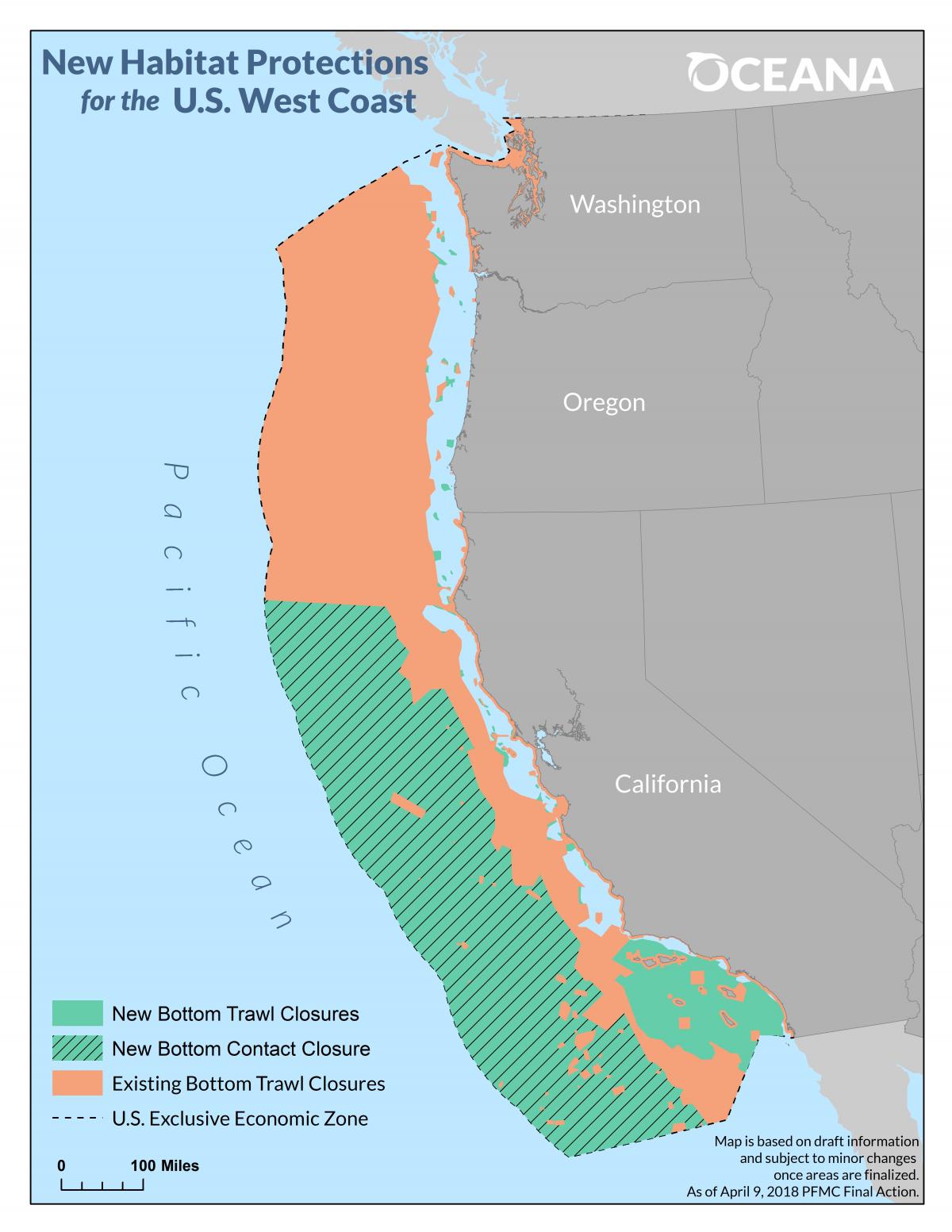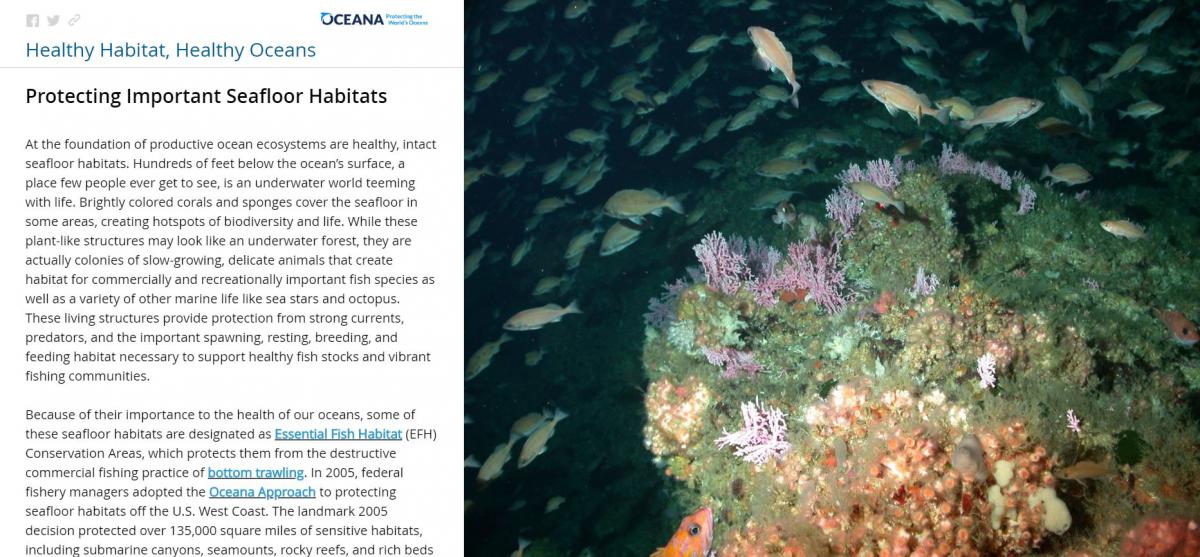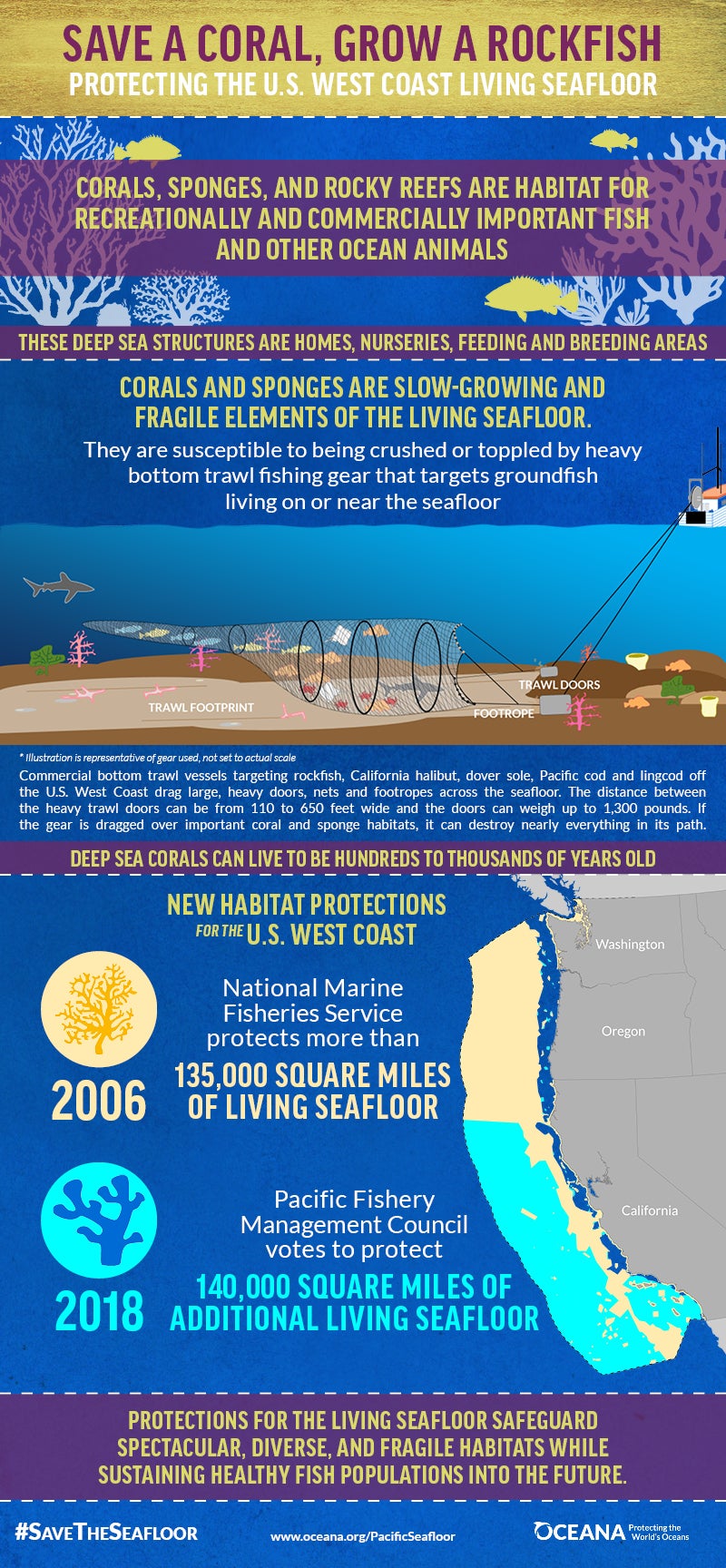Overview
See current support for protecting the living seafloor here
Victory Update: On November 11, 2018 NOAA Fisheries issued final regulations to protect more than 140,000 square miles of seafloor habitat off the U.S. West Coast from destructive bottom trawling. Places protected include corals, sponges, rocky reefs and other important areas for marine life and ocean ecosystems. These safeguards for the living seafloor are in response to a vote by the Pacific Fishery Management Council in April 2018 — following years of scientific input and advocacy by Oceana — to more than double the spatial extent of seafloor protections off California, Oregon and Washington from the impacts of bottom trawl fishing gear. The new regulations took effect on January 1, 2020, and now 90 percent of the seafloor in U.S. ocean waters off the West Coast are off limits to bottom trawling. Learn more about the final regulations here.  Seafloor habitats like coral gardens, sponge beds, and rocky reefs are designated as essential fish habitat because they provide areas for shelter, feeding, and breeding that are essential to the survival of important fish species. Explore the ocean’s living seafloor in this digital tour. The tour showcases some of the most colorful and intriguing ocean life that lives on the bottom of the ocean floor, providing habitat for larger marine species, and highlights the need to protect these areas from bottom trawling.
Seafloor habitats like coral gardens, sponge beds, and rocky reefs are designated as essential fish habitat because they provide areas for shelter, feeding, and breeding that are essential to the survival of important fish species. Explore the ocean’s living seafloor in this digital tour. The tour showcases some of the most colorful and intriguing ocean life that lives on the bottom of the ocean floor, providing habitat for larger marine species, and highlights the need to protect these areas from bottom trawling. 
Parallel to the ongoing discovery of new corals and sponges, there is a strong scientific understanding of the negative impacts fishing gears can impose on the living seafloor. Bottom trawls are large, weighted fishing nets that drag along the ocean floor to catch commercially important fish and shrimp species, and in doing so can rip up creatures and structures in their path, making this type of fishing gear the most damaging to seafloor habitats off the U.S. West Coast. Some sponge and coral species grow to be hundreds or even thousands of years old, and when ripped up or crushed by heavy trawls these corals and sponges may not recover for centuries, if at all. Bottom trawl fishing gear reduces habitat complexity, species diversity and productivity. In 2006, federal fishery managers implemented the Oceana Approach to protecting seafloor habitats off the U.S. West Coast. This approach freezes the footprint of bottom trawling by preventing the expansion of this fishing gear into deeper waters outside of currently trawled areas and closes ecological hotspots within the trawl footprint to protect living seafloor habitat like corals and sponges. That landmark decision protected more than 135,000 square miles of sensitive habitats off the U.S. West Coast, including underwater canyons, seamounts, rocky reefs, and habitats containing coral gardens and sponge beds. This approach was deemed by NOAA Fisheries to have a minimal economic impact on the West Coast bottom trawl fishery. The Pacific Fishery Management Council (Council) and NOAA Fisheries are required to review and update Essential Fish Habitat regulations every five years. In late 2010 the Council began that review process. Then, in response to a request for proposals issued by the Council, Oceana, and our conservation partners, submitted a comprehensive conservation proposal to modify existing essential fish habitat conservation areas off the U.S. West Coast and to identify and protect new areas. New coral and sponge findings from Oceana’s at-sea expeditions, in addition to other new scientific data, provided integral information supporting the merits for new and expanded seafloor protections. After a thorough review of the science and an inclusive public process, in April 2018, the Pacific Fishery Management Council adopted a modified version of Oceana’s coastwide conservation proposal. The Council’s final action is designed to protect more than 140,000 square miles of diverse and fragile seafloor habitats off the U.S. West Coast. In addition to the new conservation areas, the Council also voted to recommend portions of some existing essential fish habitat conservation areas be opened to bottom trawling, and it recommended the removal of the trawl rockfish conservation area off Oregon and California. The Council made these recommendations to increase fishing opportunities in some historic fishing grounds where bottom trawling has been prohibited in recent years to recover overfished rockfish populations, while at the same time increasing overall habitat conservation. In the end, the Council’s action is viewed by fishermen and conservationists as a “win-win” for habitat conservation and the West Coast bottom trawl fishery. Included in the Council’s final recommendations is the designation of a deep-sea conservation area off California that will protect habitats deeper than 3,500 meters (nearly 2 miles) below the surface from all bottom-contact fishing gears. This deep-sea conservation area spans over 123,000 square miles of near pristine Pacific Ocean seafloor. The Council also voted to protect 53 other special places including a large glass sponge reef near Gray’s Canyon off Washington, concentrations of rockfish that nestle into barrel sponges at Daisy Bank off central Oregon, coral forests off southern Oregon’s Crescent City, newly discovered Christmas tree corals at the Farallon Islands, coral beds in Monterey Canyon, productive offshore banks off Point Sur, and recently documented coral gardens, rocky reefs and methane seeps off Southern California. A significant part of the Council’s action was the adoption of Oceana’s proposal for a precautionary closure to future bottom trawling off Southern California. This area offshore Southern California— totaling over 16,000 square miles— is rich with deep-sea corals, sponges, rocky reefs and offshore banks and seamounts that are teeming with life and which support regional fisheries. More information about this conservation area, and what makes the ocean environment off Southern California so unique can be found here. When combined with the protections already in place, more than 90 percent of federal and state ocean waters (0 to 200 nautical miles) off the West Coast will be protected from bottom trawling. The Council’s April 2018 decision is now before NOAA Fisheries for rulemaking.
 Click here to download the infographic
Click here to download the infographic
What Oceana Does
The Oceana Approach
Oceana has identified areas that warrant protection from destructive bottom trawling through the following criteria: 1. Areas known to contain habitat features particularly sensitive to bottom trawl impacts, including hard substrate, biogenic habitats, submarine canyons, ridges, banks, escarpments, and/or other exceptional features; 2. Areas with high regional coral and/or sponge bycatch; 3. Areas within and/or adjacent to the current year-round closed portion of the groundfish trawl Rockfish Conservation Area (Trawl RCA) containing ecologically important and/or sensitive habitats important to overfished species and target species, so that these areas remain protected, if bycatch-related spatial protections are lifted; 4. Areas that improve the overall representation of habitat types contained in Essential Fish Habitat Conservation Areas in regional and coastwide contexts; 5. Areas that are adjacent to newly designated marine protected areas; 6. Areas that increase the overall level of protection for sensitive habitat types within each of the five west coast National Marine Sanctuaries; 7. Areas that are currently subject to very low or no trawl effort that may contain sensitive habitats.



